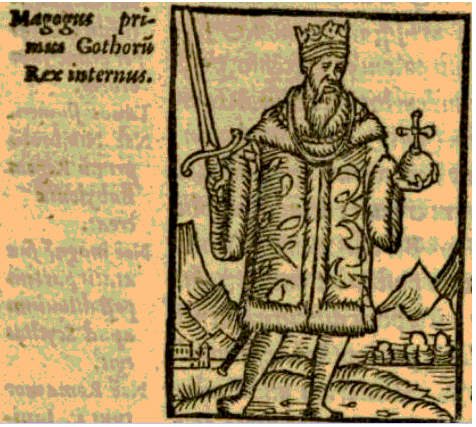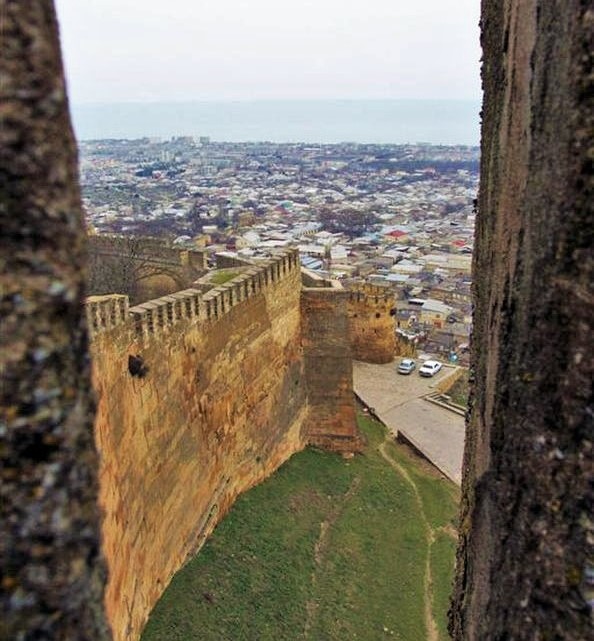|
Gates Of Alexander
The Gates of Alexander were a legendary barrier supposedly built by Alexander the Great in the Caucasus to keep the uncivilized barbarians of the north (typically associated with Gog and Magog in medieval Christian and Islamic writings) from invading the land to the south. The gates were a popular subject in medieval travel literature, starting with the '' Alexander Romance'' in a version from perhaps the 7th century AD. The wall, also known as the Caspian Gates, has been identified with two locations: the Pass of Derbent, Russia, or with the Pass of Dariel, a gorge forming a pass between Russia and Georgia with the Caspian Sea to the east. Tradition also connects it to the Great Wall of Gorgan (Red Snake) on its south-eastern shore. These fortifications were historically part of the defence lines built by the Sassanid Persians, while the Great Wall of Gorgan may have been built by the Parthians. A similar narration about such a wall is mentioned in ''al-Kahf'' ("''The Cave''" ... [...More Info...] [...Related Items...] OR: [Wikipedia] [Google] [Baidu] |
Sasanian Empire
The Sasanian () or Sassanid Empire, officially known as the Empire of Iranians (, ) and also referred to by historians as the Neo-Persian Empire, was the last Iranian empire before the early Muslim conquests of the 7th-8th centuries AD. Named after the House of Sasan, it endured for over four centuries, from 224 to 651 AD, making it the longest-lived Persian imperial dynasty. The Sasanian Empire succeeded the Parthian Empire, and re-established the Persians as a major power in late antiquity alongside its neighbouring arch-rival, the Roman Empire (after 395 the Byzantine Empire).Norman A. Stillman ''The Jews of Arab Lands'' pp 22 Jewish Publication Society, 1979 International Congress of Byzantine Studies ''Proceedings of the 21st International Congress of Byzantine Studies, London, 21–26 August 2006, Volumes 1–3'' pp 29. Ashgate Pub Co, 2006 The empire was founded by Ardashir I, an Iranian ruler who rose to power as Parthia weakened from internal strife and wars with t ... [...More Info...] [...Related Items...] OR: [Wikipedia] [Google] [Baidu] |
Alans
The Alans (Latin: ''Alani'') were an ancient and medieval Iranian nomadic pastoral people of the North Caucasus – generally regarded as part of the Sarmatians, and possibly related to the Massagetae. Modern historians have connected the Alans with the Central Asian Yancai of Chinese sources and with the Aorsi of Roman sources. Having migrated westwards and becoming dominant among the Sarmatians on the Pontic–Caspian steppe, the Alans are mentioned by Roman sources in the . At that time they had settled the region north of the Black Sea and frequently raided the Parthian Empire and the Caucasian provinces of the Roman Empire. From the Goths broke their power on the Pontic Steppe. Upon the Hunnic defeat of the Goths on the Pontic Steppe around , many of the Alans migrated westwards along with various Germanic tribes. They crossed the Rhine in 406CE along with the Vandals and Suebi, settling in Orléans and Valence. Around 409 CE they joined the Vandals and Suebi i ... [...More Info...] [...Related Items...] OR: [Wikipedia] [Google] [Baidu] |
Hyrcania
Hyrcania () ( el, ''Hyrkania'', Old Persian: 𐎺𐎼𐎣𐎠𐎴 ''Varkâna'',Lendering (1996) Middle Persian: 𐭢𐭥𐭫𐭢𐭠𐭭 ''Gurgān'', Akkadian: ''Urqananu'') is a historical region composed of the land south-east of the Caspian Sea in modern-day Iran and Turkmenistan, bound in the south by the Alborz mountain range and the Kopet Dag in the east. The region served as a satrapy (province) of the Median Empire, a sub-province of the Achaemenid Empire, and a province within its successors, the Seleucid, Arsacid and Sasanian empires. Hyrcania bordered Parthia to the east (later known as Abarshahr), Dihistan to the north, Media to the south and Mardia to the west. Etymology ''Hyrcania'' () is the Greek name for the region, a borrowing from the Old Persian ''Verkâna'' as recorded in Darius the Great's Behistun Inscription (522 BC), as well as in other Old Persian cuneiform inscriptions. ''Verkā'' means "wolf" in Old Iranian, cf. Avestan ''vəhrkō'', Gila ... [...More Info...] [...Related Items...] OR: [Wikipedia] [Google] [Baidu] |
The Jewish War
''The Jewish War'' or ''Judean War'' (in full ''Flavius Josephus' Books of the History of the Jewish War against the Romans'', el, Φλαυίου Ἰωσήπου ἱστορία Ἰουδαϊκοῦ πολέμου πρὸς Ῥωμαίους βιβλία, ''Phlauiou Iōsēpou historia Ioudaikou polemou pros Rōmaious biblia''), also referred to in English as ''The Wars of the Jews'', is a book written by Josephus, a first-century Roman-Jewish historian. It has been described by Steve Mason as "perhaps the most influential non-biblical text of Western history". Content Divided into seven books, it opens with a summary of Jewish history from the capture of Jerusalem by the Seleucid ruler Antiochus IV Epiphanes in 168 BC to the first stages of the First Jewish–Roman War (Book I and II). The next five books detail the unfolding of the war, under Roman generals Vespasian and Titus, to the death of the last Sicarii. The book was written about 75 AD, originally in Josephus' "pat ... [...More Info...] [...Related Items...] OR: [Wikipedia] [Google] [Baidu] |
Magog (Bible)
Magog (; Hebrew: מגוג ; Greek: Μαγώγ) is the second of the seven sons of Japheth mentioned in the Table of Nations in Genesis . The origin of the term is not clear, this name indicates either a person, or a tribe, or a geographical reality (country or city). In the book of Ezekiel, the pagan Magog people live "north of the World", and metaphorically represent the forces of Evil, which associates it with Apocalyptic traditions. Etymology The origin of the name ''Magog'' is unclear. It has been conjectured to come from the Akkadian ''mat Gugi'', "land of Gog", that is, the land of Gyges: Lydia. In the Bible Magog is often associated with apocalyptic traditions, mainly in connection with Ezekiel 38 and 39 which mentions " Gog of the land of Magog, the chief prince of Meshech and Tubal" (Ezek 38:2 NIV); on the basis of this mention, " Gog and Magog" over time became associated with each other as a pair. In the New Testament, this pairing is found in the Book of ... [...More Info...] [...Related Items...] OR: [Wikipedia] [Google] [Baidu] |
Josephus
Flavius Josephus (; grc-gre, Ἰώσηπος, ; 37 – 100) was a first-century Romano-Jewish historian and military leader, best known for '' The Jewish War'', who was born in Jerusalem—then part of Roman Judea—to a father of priestly descent and a mother who claimed royal ancestry. He initially fought against the Romans during the First Jewish–Roman War as head of Jewish forces in Galilee, until surrendering in 67 AD to Roman forces led by Vespasian after the six-week siege of Yodfat. Josephus claimed the Jewish Messianic prophecies that initiated the First Jewish–Roman War made reference to Vespasian becoming Emperor of Rome. In response, Vespasian decided to keep Josephus as a slave and presumably interpreter. After Vespasian became Emperor in 69 AD, he granted Josephus his freedom, at which time Josephus assumed the emperor's family name of Flavius.Simon Claude Mimouni, ''Le Judaïsme ancien du VIe siècle avant notre ère au IIIe siècle de notre ère : ... [...More Info...] [...Related Items...] OR: [Wikipedia] [Google] [Baidu] |
Natural History (Pliny)
The ''Natural History'' ( la, Naturalis historia) is a work by Pliny the Elder. The largest single work to have survived from the Roman Empire to the modern day, the ''Natural History'' compiles information gleaned from other ancient authors. Despite the work's title, its subject area is not limited to what is today understood by natural history; Pliny himself defines his scope as "the natural world, or life". It is encyclopedic in scope, but its structure is not like that of a modern encyclopedia. It is the only work by Pliny to have survived, and the last that he published. He published the first 10 books in AD 77, but had not made a final revision of the remainder at the time of his death during the AD 79 eruption of Vesuvius. The rest was published posthumously by Pliny's nephew, Pliny the Younger. The work is divided into 37 books, organised into 10 volumes. These cover topics including astronomy, mathematics, geography, ethnography, anthropology, human physio ... [...More Info...] [...Related Items...] OR: [Wikipedia] [Google] [Baidu] |
Pliny The Elder
Gaius Plinius Secundus (AD 23/2479), called Pliny the Elder (), was a Roman author, naturalist and natural philosopher, and naval and army commander of the early Roman Empire, and a friend of the emperor Vespasian. He wrote the encyclopedic '' Naturalis Historia'' (''Natural History''), which became an editorial model for encyclopedias. He spent most of his spare time studying, writing, and investigating natural and geographic phenomena in the field. His nephew, Pliny the Younger, wrote of him in a letter to the historian Tacitus: Among Pliny's greatest works was the twenty-volume work ''Bella Germaniae'' ("The History of the German Wars"), which is no longer extant. ''Bella Germaniae'', which began where Aufidius Bassus' ''Libri Belli Germanici'' ("The War with the Germans") left off, was used as a source by other prominent Roman historians, including Plutarch, Tacitus and Suetonius. Tacitus—who many scholars agree had never travelled in Germania—used ''Bella Ger ... [...More Info...] [...Related Items...] OR: [Wikipedia] [Google] [Baidu] |
Bessus
Bessus or Bessos ( peo, *Bayaçā; grc-gre, Βήσσος), also known by his throne name Artaxerxes V ( peo, 𐎠𐎼𐎫𐎧𐏁𐏂𐎠 ; grc-gre, Ἀρταξέρξης; died summer 329 BC), was a Persian satrap of the eastern Achaemenid satrapy of Bactria, as well as the self-proclaimed King of Kings of the Achaemenid Empire from 330 to 329 BC. A member of the ruling Achaemenid dynasty, Bessus came to power shortly after killing the legitimate Achaemenid ruler Darius III (), and subsequently attempted to hold the eastern part of the empire against the Macedonian king Alexander the Great (). His realm quickly started to fall apart, including Bactria, which was the main center. Fleeing into Sogdia, he was arrested by his own officers, who handed him over to Alexander, who had him executed at Ecbatana. Bessus appears in the 11th-century Persian epic ''Shahnameh'' under the name of Janusipar/Janushyar. Name "Bessus" (Βήσσος) is the Greek transliteration of the Old ... [...More Info...] [...Related Items...] OR: [Wikipedia] [Google] [Baidu] |
Dhul-Qarnayn
, ( ar, ذُو ٱلْقَرْنَيْن, Ḏū l-Qarnayn, ; "He of the Two Horns") appears in the Quran, Surah Al-Kahf (18), Ayahs 83–101 as one who travels to east and west and sets up a barrier between a certain people and Gog and Magog (called Ya'juj and Ma'juj). Elsewhere the Quran tells how the end of the world will be signaled by the release of Gog and Magog from behind the barrier. Other apocalyptic writings predict that their destruction by God in a single night will usher in the Day of Resurrection (''Yawm al-Qiyāmah)''. Early Muslim commentators and historians variously identified , most notably as Alexander the Great and as the South-Arabian Himyarite king al-Ṣaʿb bin Dhī Marāthid. Some modern scholars have argued that the origin of the Quranic story may be found in the ''Syriac Alexander Legend,'' but others disagree. Although some favor identification of with Cyrus the Great, the majority of modern scholars and commentators still prefer Alexander the ... [...More Info...] [...Related Items...] OR: [Wikipedia] [Google] [Baidu] |





.jpg)
